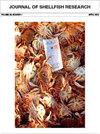Settlement of the Bay Scallop (Argopecten irradians) along the Gulf Coast of Florida
IF 1
4区 农林科学
Q3 FISHERIES
引用次数: 0
Abstract
ABSTRACT Before collapsing, bay scallops (Argopecten irradians) supported commercial fisheries in Florida but, following decades of restoration efforts and management actions, still support a recreational fishery. Settlement was monitored along the west coast of Florida from 1992 through 2018, using collector traps. The primary environmental variables retained in the analyses included temperature, salinity, and red tide concentration (Karenia brevis). The settlement rate generally increased for the first days of trap deployment, then leveled off or declined. Settlement peaked when the average water temperatures were between 21°C and 23°C at four sites: St. Andrew Bay, St. Joseph Bay, West Coast, and Pine Island Sound, indicative of a fall peak in spawning. At the Tampa Bay and Sarasota Bay sites, settlement peaked when temperatures were around 16°C, indicative of winter spawning. At most sites, the highest peak in settlement occurred in association with declines in temperature of 10°C–15°C during the fall, with a smaller, secondary peak occurring with similar increases in temperature during the spring. Warming winter temperatures may already be negatively affecting the ability of the subpopulations to synchronously spawn, with unknown impacts to population dynamics. At all sites, settlement declined rapidly when salinity fell below 30 with little settlement occurring below 27, and approached zero when salinity fell below approximately 20. The occurrence of K. brevis exceeding 10,000 cells/L resulted in reduced settlement. In the core populations of West Coast and Steinhatchee, K. brevis was uncommon, and settlement resumed rapidly when blooms abated. For sites outside the core population, settlement was reduced for 2–4 y after red tides. Recovery of populations in these noncore sites probably relies on exogenous supply of larvae from the core. If blooms of K. brevis that penetrate the core region, as was observed in 2021, become more severe, more frequent, or have longer durations, the entire Florida scallop population could be endangered.海湾扇贝(Argopecten irradians)在佛罗里达州海湾沿岸的定居情况
摘要 海湾扇贝(Argopecten irradians)在崩溃之前曾支持佛罗里达州的商业渔业,但经过数十年的恢复努力和管理行动,目前仍支持休闲渔业。从 1992 年到 2018 年,使用收集器诱捕器对佛罗里达西海岸的沉降情况进行了监测。分析中保留的主要环境变量包括温度、盐度和赤潮浓度(Karenia brevis)。沉降率一般在设置诱捕器的最初几天上升,然后趋于平稳或下降。在圣安德鲁湾、圣约瑟夫湾、西海岸和松岛湾这四个地点,当平均水温介于 21 摄氏度和 23 摄氏度之间时,沉降达到峰值,表明产卵高峰期在秋季。在坦帕湾和萨拉索塔湾,当气温在 16°C 左右时,沉降达到高峰,表明是冬季产卵。在大多数地点,秋季气温下降 10°C-15°C 时会出现沉降最高峰,春季气温升高时会出现一个较小的次高峰。冬季气温升高可能已经对亚群同步产卵的能力产生了负面影响,对种群动态的影响尚不清楚。在所有地点,当盐度低于 30 时,沉降量迅速下降,低于 27 时沉降量极少,当盐度低于约 20 时,沉降量接近于零。当 K. brevis 超过 10,000 cells/L 时,沉降量也会减少。在 West Coast 和 Steinhatchee 的核心种群中,K. brevis 并不常见,藻华消退后,沉降会迅速恢复。在核心种群以外的地点,赤潮过后的 2-4 年间,沉降量减少。这些非核心地点的种群恢复可能依赖于核心区的外源幼虫供应。如果像 2021 年观察到的那样,K. brevis 的藻华渗透到核心区域,变得更严重、更频繁或持续时间更长,那么整个佛罗里达扇贝种群都可能濒临灭绝。
本文章由计算机程序翻译,如有差异,请以英文原文为准。
求助全文
约1分钟内获得全文
求助全文
来源期刊

Journal of Shellfish Research
生物-海洋与淡水生物学
CiteScore
2.30
自引率
0.00%
发文量
40
审稿时长
6 months
期刊介绍:
Original articles dealing with all aspects of shellfish research will be considered for publication. Manuscripts will be judged by the editors or other competent reviewers, or both, on the basis of originality, content, merit, clarity of presentation, and interpretations.
 求助内容:
求助内容: 应助结果提醒方式:
应助结果提醒方式:


